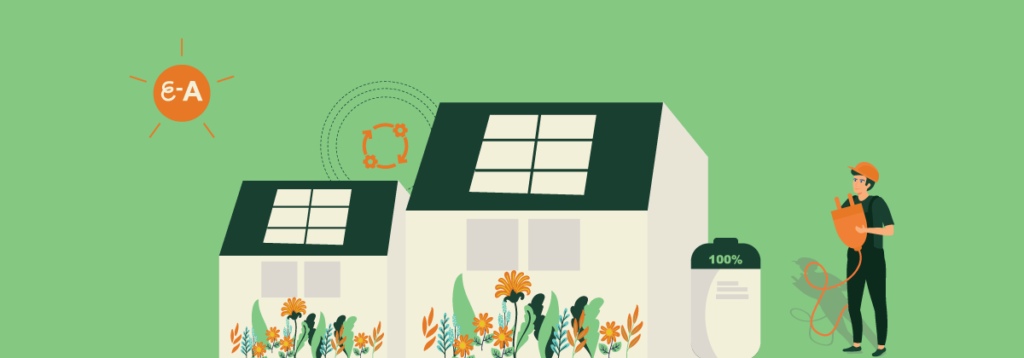In the last few years the adoption of battery storage for residential solar systems has seen a big increase. Historically, storage batteries were only really practical for off-grid type installations. They just weren’t a consideration for standard homeowners.
However, just as solar panel prices have experienced a dramatic decrease over the past decade, battery prices have followed suit. This has been the main driver, alongside the green energy advantages they bring.
What’s even better, as the prices have dropped, batteries have become more advanced and efficient. As a result, we’ve seen battery storage become an increasingly attractive option for many grid-tied solar systems.
So, if you find that your solar panels are generating a substantial amount of energy when you’re not home, and most of it is being sent to the national grid, it may be time to consider adding battery storage to your solar system. This article will bring you up to speed on the process of adding a new battery system into your existing solar setup.
Why add battery storage to your solar panels?

Adding solar battery storage into your home’s energy system can be a huge step in revolutionising the way you capture and use the power generated by your own PV panels. Yes solar panels have advantages with or without battery storage, but incorporating solar battery storage really helps to maximise your energy savings.
The most cost-effective electricity is the energy you generate yourself. By storing excess energy produced by your solar panels during high sunlight hours, you can avoid feeding it back into the grid or selling it at a lower price than what you’d have to buy the electricity back at. Without a battery, any surplus energy your home produces is essentially wasted for you.
Whilst there’s a sizable upfront cost to solar storage batteries, the long-term financial benefits make it a smart investment.
Alongside making the most of your own solar power, batteries give you more energy independence, help to lower your monthly bills, store cheap energy, contribute to a cleaner environment and prepare your home for what’s coming in the future. You can read up on more reasons you should get battery storage here.
Benefits of adding a battery solar panels
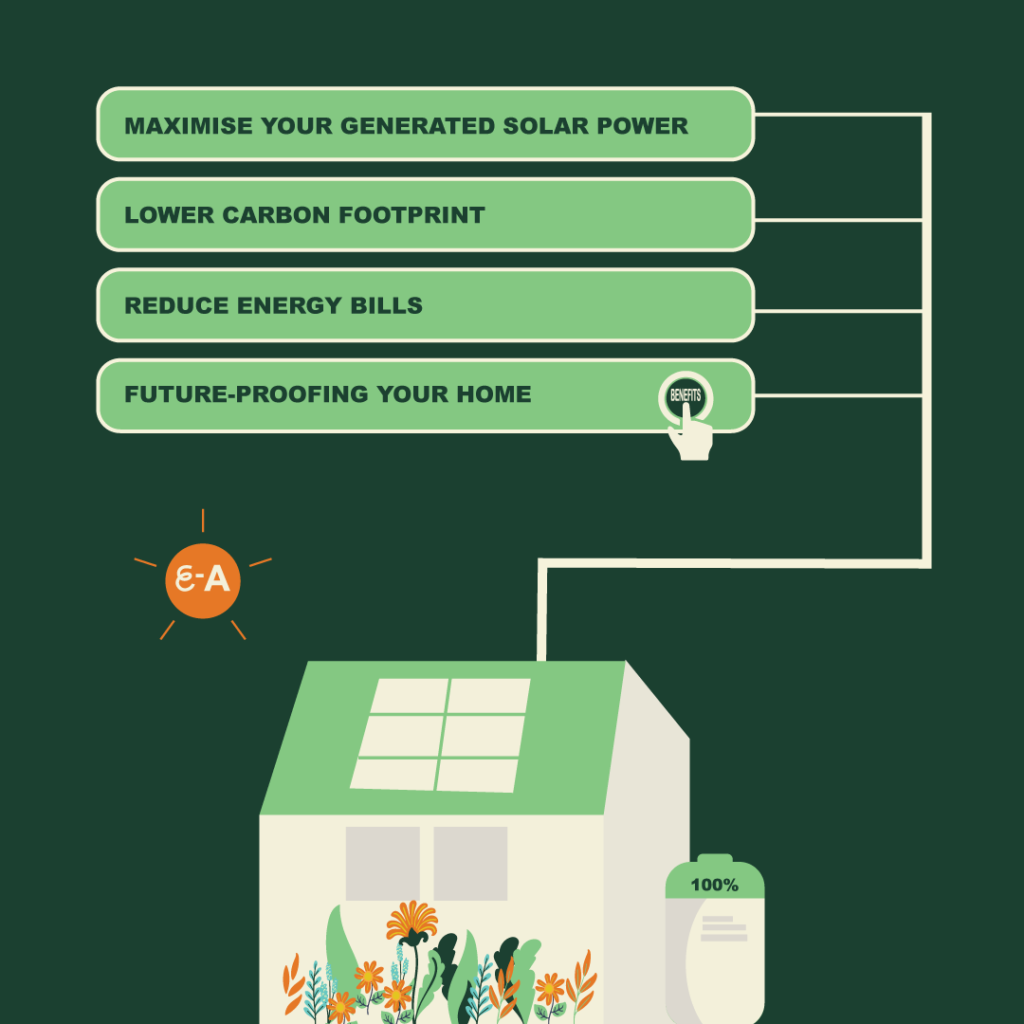
Maximise your generated solar power
Without a battery, any surplus energy generated by your solar panels during the day is sent back to the grid. Whilst this can earn you a small return through the Smart Export Guarantee (SEG), it’s often less than what you’d pay to buy that energy back later.
A battery lets you store this excess energy for use during the evening or at night, allowing you to fully maximise the renewable energy your system generates.
Lower carbon footprint
As you know, solar batteries allow you to use more of your own green energy and rely less on grid electricity, which is still heavily reliant on the fossil fuel industry.
According to the Energy Saving Trust, a standard size solar battery system can save around a tonne of carbon emissions annually, equivalent to driving 3,600 fewer miles in a petrol car.
Reduce energy bills
Stored solar energy offsets the electricity you’d otherwise buy from the grid. In the grand scheme of things, becoming more energy independent means you’ll significantly lower your bills as well as giving you greater control over your energy use.
Alongside this, you can use your battery to charge up during cheap off-peak grid hours and discharge stored power during expensive peak times to further maximise your savings.
Future-proofing your home
Battery storage prepares your home for a future where energy demands will increase due to electrification, such as with electric vehicles and heat pumps. Starting with battery technology now allows easy integration of these innovations later.
Even if you already have solar panels installed, retrofitting a battery to your existing system should be a straightforward process. AC-coupled batteries, for example, are specifically designed for this purpose, connecting to your current solar setup without requiring changes to your panels or inverter.
This flexibility means you can upgrade your system incrementally, starting with solar panels and adding a battery when it fits your budget. Retrofitting not only boosts your energy efficiency but also ensures your home is ready for the next wave of renewable energy technologies.
For more on why battery storage is a major plus for your solar panel array, read this guide on the benefits of solar battery storage.
Can I add battery storage to my existing solar system?

Yes, you can certainly add battery storage to your existing solar system. Just how simple or straightforward this is depends on your current setup. It all comes down to the inverter.
Just as not all phone chargers work for every mobile, not every solar battery works with every solar panel inverter. So, there may be a bit of rejigging here and swapping of inverters. However, the main thing is that a solution is possible.
When selecting a battery, you’ll also have to consider other factors such as the best capacity for your home, the desired depth of discharge (the higher the better) and warranty periods. For example, choosing a battery with a high DoD and an extended warranty will help optimise your system performance and longevity, making the most of your investment.

What’s the best integration method for battery storage on a solar system?
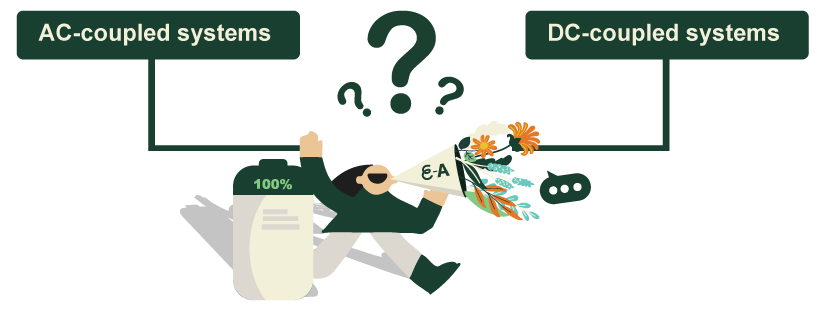
This is the crucial question when adding battery storage to a solar panel system. And it comes down to two main options: an AC-coupled system or DC-coupled system.
The decision isn’t straightforward and hinges on a few factors. If you’re not fully clued up on how solar is sent to the battery, have a read here on the basics of home battery storage.
AC-coupled systems
AC-coupled systems integrate the battery into the main AC circuit, which comes after the solar inverter. This approach is the most straightforward way to retrofit a battery into an existing solar set-up, particularly if your inverter is older.
In this configuration, a separate inverter is used to charge the battery. The inverter converts the DC power from your panels to AC power, which is then directed to your home to power your appliances or sent to the grid. This is based on your energy consumption and the battery’s charge status.
AC-coupled systems are generally easier to install, provide flexibility in terms of placement, and are compatible with a range of inverters. However, they are slightly less efficient due to the multiple power conversions involved.
DC-coupled systems
On the other side, DC-coupled systems connect the battery directly to the solar panel’s DC output. This comes before the inverter.
This setup is typically more efficient as it minimises energy losses during the conversion process. If you have this configuration with your current solar panels, your existing solar inverter will be replaced with a hybrid inverter that’s compatible with both the battery and solar system.
With this configuration, DC power from your solar panels charges the battery. The hybrid inverter then converts the DC power into AC electricity for use in your home. DC coupling could be an excellent choice if your solar system is older and your inverter is nearing the end of its expected lifespan. Read up here on how long solar batteries last for.
Finally on the integration, if you’re installing solar panels today with the intention of adding batteries in the future, a ‘storage ready’ option might be the most suitable route. In this case, the inverter is already prepared for the installation of a battery when it becomes financially viable for you.
What size battery capacity do you need for a solar array?
When sizing a domestic battery storage system for your solar installation, there are several core factors to consider:
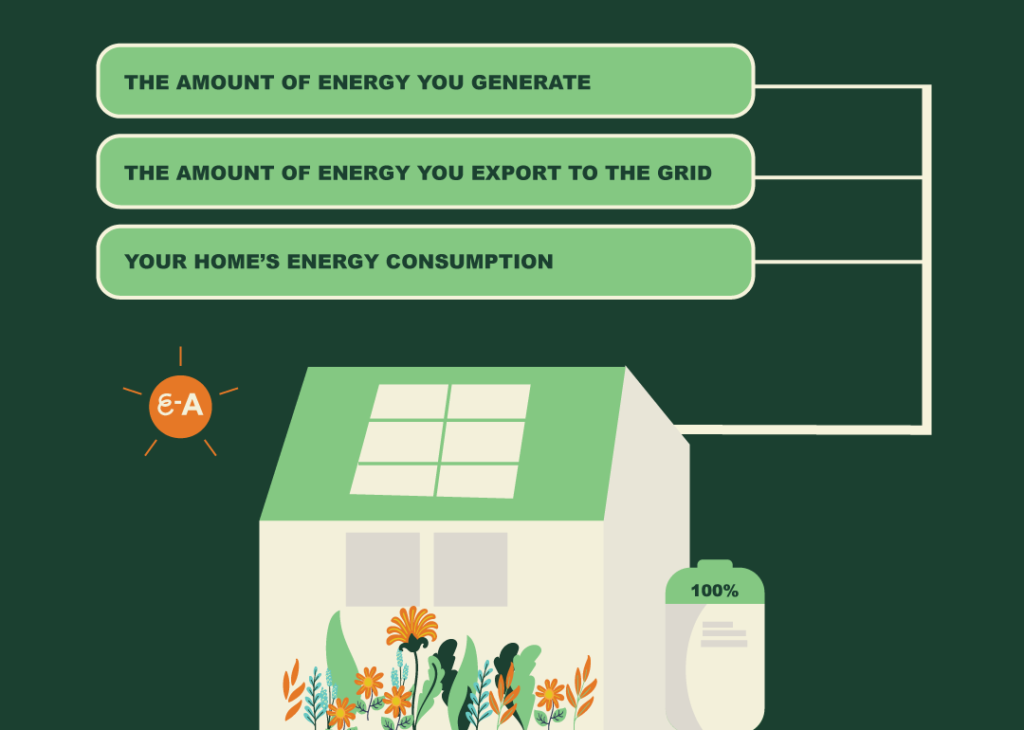
- The amount of energy you generate – If you have solar panels installed already, how much energy is being generated on a daily basis? Work out your averages across the months and years.
- The amount of energy you export to the grid – How much of the energy generated do you export to the national grid? Review your readings and calculate your average export in kWh. This will give you an idea of the available energy that you generally have to send to a battery, rather than to the grid.
- Your home’s energy consumption – The most crucial factor is knowing your home’s average daily energy consumption. This will provide you with a baseline understanding of your typical electricity usage and, consequently, the amount of energy you need to store.
Striking the right balance between these factors and others, such as your budget, is crucial.
Whilst most people invest in a battery storage system to reduce their reliance on the grid and save money on energy bills, it’s important to have realistic expectations. Unless you have an exceptionally large battery capacity, you’ll still need to buy electricity from the grid throughout the year. Powering your home solely from battery storage is generally not feasible as you’d require a huge battery capacity.
However, when it comes to battery storage, it’s always better to err on the side of a slightly larger capacity. This will provide more flexibility and energy security in the long run. To give you an idea on size:
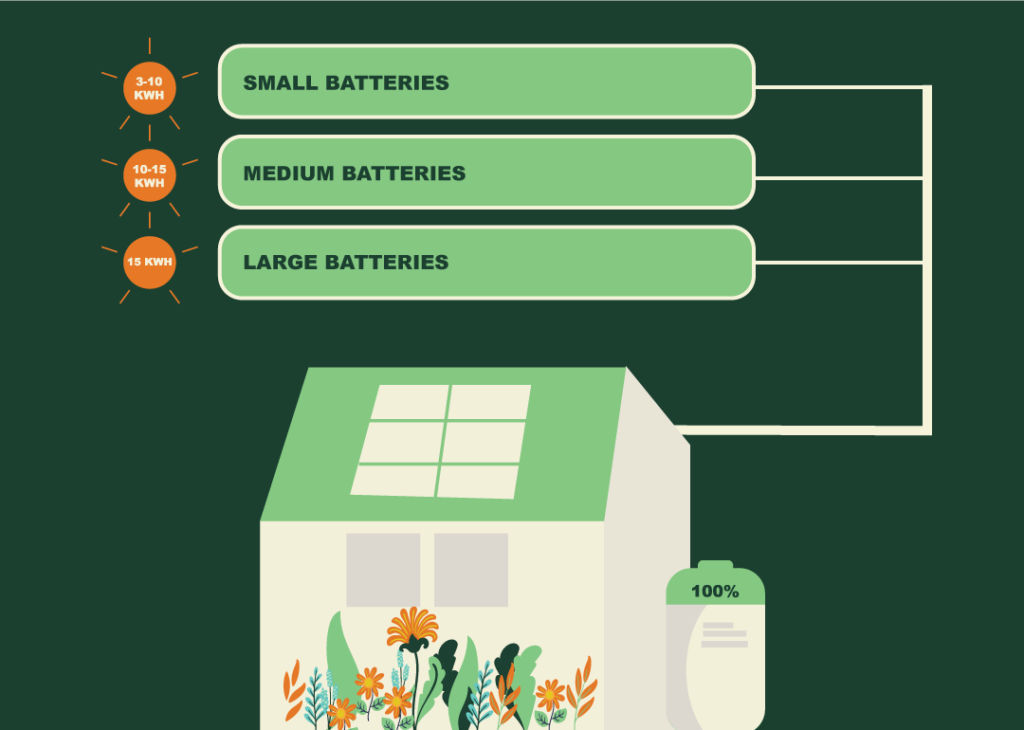
- Small batteries – A small solar battery storage system will be sized between 3-10 kWh. A fully charged small solar battery is usually sufficient for powering the bare essentials of a family residence for a full day, such as refrigerators, lighting and electronic devices. However, powering your heating, as well as everything else from this, will be problematic.
- Medium batteries – A medium battery storage system can hold between 10-15kWh. A fully charged medium solar battery can cover most of the home’s energy needs for a day or two.
- Large batteries – Large batteries are capable of storing around 15kWh of energy and above. With these batteries, you’ll be more energy independent and may be able to sell electricity back to the grid to generate a side income.
You can read much more on how to calculate battery storage size for solar panels here.
Installing battery storage: a step-by-step process
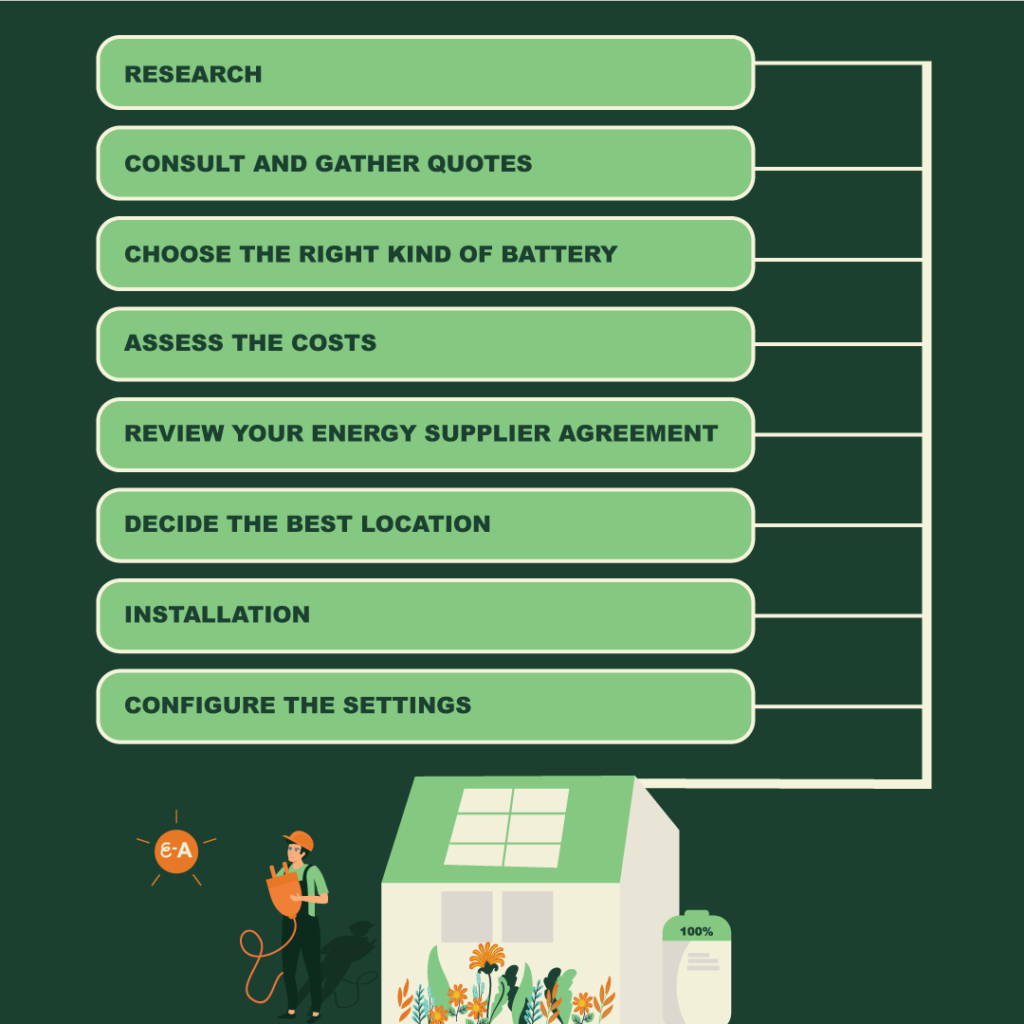
Adding battery storage to your existing solar panel system is a multi-step process. It involves careful planning and professional installation.
Here’s a step-by-step guide to help you navigate the process:
- Research – Brands, installers, and battery systems: Begin by thoroughly researching battery brands, systems and local businesses to familiarise yourself with the available options and their features. It’s always good to have at least a basic understanding.
- Consult and gather quotes – Contact the companies you like to discuss your specific needs and home setup in more detail. Arrange for them to visit your home and provide quotes and expert advice tailored to your situation.
- Choose the right kind of battery – Battery system, size/capacity, and integration method: Based on your research and consultations, decide on the type of battery system you want, the appropriate capacity for your needs and the preferred integration method. Generally speaking, you can install 2 to 3 batteries to your solar panel system depending on your energy requirements.
- Assess the costs – Evaluate the costs associated with both purchasing and installing the chosen battery system. Depending on the size, manufacturer and battery type, costs are usually in the region of £2,500 to £10,000+.
- Review your energy supplier agreement – Check with your energy supplier to see if you need to update or change your agreement to get the best deal. This is particularly appropriate when selling excess energy back to the grid. Current suppliers tend to offer the best rates here.
- Decide the best location – Most homes don’t have too many options here but your installer will provide expert insights. A suitable location for your battery storage system needs to be well-ventilated and not exposed to extreme temperatures. Ensure the area is easily accessible for maintenance and has the necessary space for the equipment. Find out how big battery storage systems are.
- Installation – Arrange for a professional installer to fit the battery system into your mains electricity system and connect it to your existing solar panels.
- Configure the settings – Work with your installer to set up the system settings and monitoring software. This will allow you to track your energy generation, consumption and storage, as well as optimise your system’s performance.
This last point is important when it comes to maximising efficiencies. By monitoring your system’s performance, you can make sure everything is working as efficiently as possible and that you’re making the biggest cost savings. Regularly reviewing your energy consumption patterns and adapting your battery’s charging and discharging cycles will help you get the most out of your investment and reduce your reliance on the grid.
How much does it cost to add battery storage to a solar system?

The cost of installing battery storage as a retrofit to your solar panels can range from £3,000 to £10,000. This price is influenced by factors like battery capacity, brand and installation complexity.
To give you an idea, a standard 5kWh battery, suitable for a three-bedroom home, will cost around £4,500. A larger battery with a capacity of 10-15kWh will cost between £6-10,000. Generally speaking, the bigger the battery, the more it will cost upfront. The power output, or the rate that energy is delivered, also impacts cost.
Most modern batteries use lithium-ion technology, which is known for its efficiency and longevity. They usually come with warranties that last 10 to 15 years. Some premium brands offer extended warranties and guarantees, such as 6,000 cycles or 80% capacity retention. The longer your batter lasts, the more cost-effective it will be.
Installation costs usually fall between £500 and £2,000. This depends on how many people are on site plus how complex it is to integrate the battery into your existing solar system. This may involve upgrading electrical systems or replacing components like inverters.
Although the upfront costs are significant, battery storage will deliver long-term savings. Homeowners usually see payback periods of 5 to 10 years, depending on use patterns, battery size and energy tariffs.For a more detailed look at battery models and their prices, see our guide to the best battery storage systems in the UK.
What are the downsides of adding solar battery storage?
It’s clear that solar battery storage offer plenty of advantages, but there are some considerations and potential downsides to keep in mind.
The most significant barrier for many homeowners is the initial investment. With prices averaging around £5,000, adding a battery to your solar system can be expensive. But they can help you save a significant amount on your energy bills – around £800 a year according to the Energy Savings Trust for a standard 3 bed home.
Another downside is that batteries have finite storage capacities, meaning they can only hold so much energy at a time. For most households, this means they won’t entirely eliminate the need for grid electricity, particularly during winter months or periods of high energy use. Unless you have a large-scale battery system, you’ll still need to import some energy, though your grid reliance will be significantly reduced.
Modern lithium-ion batteries are incredibly safe and durable, but improper installation or inadequate ventilation can pose a risk of overheating. Make sure any battery storage retrofit is done by a certified professional installer with a proven track record.
Wrap up on adding battery storage
Wrap up on adding battery storage.
Adding battery storage to an existing solar panel system is a viable and beneficial option for many UK homeowners. By carefully assessing your energy needs, researching available battery systems and working with professionals who know what they’re doing, you can successfully integrate a battery solution that fully complements your solar setup.
FAQS
Do I need a battery if I have solar panels?
Not necessarily. Solar panels alone can significantly reduce your energy costs and carbon footprint by generating electricity during daylight hours. However, adding a battery allows you to store excess solar energy to use during the evening, overnight and potentially in the morning. Without a battery, unused solar power is exported to the grid, often at a lower rate than what you pay for grid electricity.
What is the lifespan of a solar battery?
The lifespan of a solar battery depends on its type and your usage. Lithium-ion batteries usually last 10–15 years. Using as per the guidelines can extend this lifespan, whilst factors like extreme temperatures or overcharging can shorten it.
Why add batteries to a solar system?
Adding batteries allows you to store the excess energy your panels generate, reducing grid reliance and energy bills. Batteries also provide backup energy during power cuts and allow you to make the most of off-peak energy tariffs so you can make additional cost savings.
Can I add a battery to an existing solar system?
Absolutely, batteries can be retrofitted to existing solar systems. The ease of installation depends on your current setup, particularly the inverter. Systems with hybrid inverters are often easier to integrate with batteries. If your system requires an additional inverter, an AC-coupled inverter may be the most practical approach.
What solar batteries are compatible with your panels?
Most modern solar panels are compatible with a range of solar batteries, but it’s important to check with your installer or panel manufacturer. Popular brands like Tesla Powerwall and GivEnergy All in One are widely compatible with residential solar systems. Always confirm compatibility with your existing inverter or plan for upgrades if needed.
